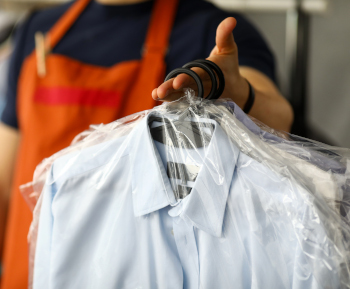How big is the industry today?

Everyone is concerned about the health and size of the dry cleaning and laundering industry coming out of the COVID-19 pandemic. We all “suspect” the industry has shrunk — but by how much? How can you find out?
The Internet is a great source for statistical information, some of it great, some of it merely confusing. Here are some statistics gleaned from various sources (all cited) to get you some insight into what has happened in the last few years.
Different viewpoints
The reason numbers were gathered has a bearing on what they really mean, and how accurate they may be. Information assembled to help potential investors is bound to be a bit different from government statistics used for taxation and other purposes. But if you combine both viewpoints, you can come pretty close to the truth.
DRY CLEANING INDUSTRY IN CANADA
Source 1: IbisWorld, a market research company that assembles detailed (and pricey) reports for those seeking investment data on different industries.
Note: While we could not access the vast majority of the report on Canada without paying huge subscription fees, we could at least pull some key numbers to give you a look at the industry as of October 2021.

IBISWorld defines the industry in Canada this way: “The Dry Cleaners industry in Canada provides full-service laundering and dry cleaning services to household consumers and commercial clients, such as hospitals, hotels, restaurants and nonprofit organizations. The industry also provides specialty cleaning services for hard-to-clean garments and textiles, such as fur, leather, suede, wedding gowns and draperies, as well as tailoring and alteration services. The largest market for industry operators is households, which are estimated to account for nearly two-thirds of revenue in 2021. Since households generate the majority of the industry’s revenue, trends in per capita disposable income and consumer spending are primary economic demand determinants for the industry.”
Specific numbers include:
- Market size: $993m
- Number of businesses: 2953
- Employing how many? 9230 (so an average of 3.12 people per company)
Biggest names in the industry (the study noted “there are no major players with market share of over 5%”)
- Certified Restoration Drycleaners Network
- Perth’s Dry Cleaners
- Cadet Cleaners
- Martinizing Dry Cleaners
The report naturally had a heavy focus on the toll that COVID-19 has had on the industry, both from the standpoint of drop in business and ongoing cultural changes that may result from this two-year period.
“The Dry Cleaners industry in Canada is expected to experience challenging operating conditions as downstream demand for industry services remains suppressed due to pandemic-related disruptions and altered work arrangements. Many smaller operators may be forced to exit the industry due to the financial burdens created by the COVID-19 (coronavirus) pandemic.”
Another view
In contrast to investor reports, statistics gathered by Statistics Canada are more cut-and-dried (and often harder to interpret).
NOTE: The numbers available from Statistics Canada on dry cleaning are “as of 2020”. Though the COVID situation makes much of that out-of-date, it is also striking to see where the industry was in 2020, compared to where IBISWorld estimates it is as of late last year. Shrinkage has been great.
Statistics Canada divides dry cleaners into “employers” and “non-employers/indeterminant” meaning they counted those with payroll withholding differently from those without. That doesn’t mean these companies didn’t have employees (they may well have had contract laborers), but that taxes were not withheld for them. We’ve combined these two numbers below to show the size of the industry before COVID caused such havoc.
As of 2020:
- Number of companies: 2238 (employers) + 2145 (non-employers/indeterminant) = 4383
- Ontario: 1002 + 1242 = 2244
- Quebec: 447 + 419 = 866
- British Columbia: 316 + 225 = 541
- Alberta: 299 + 149 = 448
- Manitoba: 58 + 37 = 95
- Saskatchewan: 48 + 26 = 74
- New Brunswick: 20 + 9 = 29
- (Other provinces are under 20, or zero)
LINEN AND UNIFORM RENTAL INDUSTRY IN CANADA

IBISWorld describes the Industrial Laundry and Linen Supply market in Canada this way: “Operators in the Industrial Laundry and Linen Supply industry in Canada supply laundered items, such as uniforms, gowns and coats, table linens, bed linens, towels, diapers, clean room apparel and treated mops to various other industries. These items are provided on a rental or contract basis. Typical clients include industrial plants, healthcare, food service and hospitality establishments.”
Specific numbers include:
- Market size: $923m
- Number of businesses: 310
- Employees: 8333 (so, and average of 26.8 per company)
Major players:
- Aramark Corp.
- Cintas Corp.
- UniFirst Corp.
- Alsco Inc.
The report noted that while COVID-19 had an adverse impact on this part of the industry, it has not been nearly as great as on dry cleaning, and the uptick in need for sanitized linens by healthcare sectors has helped offset the drop in linens from hospitality and restaurant clients.
The Government’s view
Statistics Canada information was dated 2019 in some places, which makes it less valuable as an indicator of today, but really interesting for comparison purposes.
Number of businesses: 299
- Ontario: 85
- Quebec: 44
- Alberta: 27
- British Columbia: 26
- (All other provinces were single digits, or zero)
Average revenue: $724.3 thousands (we assume per company)
So the answer is . . . ?
By comparing some of the information above from both sources, it’s clear a great deal of shrinkage has occurred in the dry cleaning sector (perhaps as much as half) and that industrial laundry and uniform rental has remained relatively constant. Yes, that’s what your gut probably told you — but now you have the numbers to back it up.
If you want to see US statistics for comparison, there are numerous sources online. Here’s one you may want to look at:
US Statistics article — good information, but a very annoying guy waving at you all the time in the lower right corner of your screen. Just keep a post-it note handy for him.






COMMENT FROM SID CHELSKY (posted by Becca Anderson due to technical issue)
Good afternoon, Becca,
I have difficulty with the article on how big our industry is. Recently, on a DLI webinar for top operators, it was learned that the United States estimated the number of cleaners at 25,000. This was proven to be erroneous as the information they rely on is from payroll taxes. Many operators do not report their payroll, and many operate on a cash basis only. The real number is at least double.
The Government of Canada and the provincial governments do not think we are influential in our ability to lobby them, as they think we do not contribute to the taxation of this country. This may be true of some operators, but the honest and good operators report their sales and payroll and pay their taxes. They employ a great many people.
There has been a drop of at least 30% of the cleaning operations due to the pandemic. I believe that most were companies that were not part of any association, could not afford to pay rents and decided to close their plants and depots, and had they been part of an association such as the Canadian Fabricare Association or DLI, etc., then they would have had access to forums that would have helped them cope with the financial problems and find new ways to maintain their business. The only losses of members from our association were a few that decided to retire now and be faced with dealing with the epidemic. DLI is reporting similar situations.
I also wonder what the percentage of companies that are mentioned are only depots and therefore have few employees.
Sidney Chelsky,
Executive Director,
Canadian Fabricare Association
EDITOR’S REPLY:
The thing about numbers is that you are never really sure what is behind them — both in an information-gathering sense, and an agenda sense. What I found interesting is that the report from IBISWorld, which I would expect to be upbeat since it’s for investors, and Statistics Canada, which I would expect to be governmentally rigid and accurate, both had a fairly similar view of the industry.
On the point about depots vs. companies, I’d wondered that, too. But none of the things I looked at broke it out that way. It would almost have to include them, though, because otherwise the industry numbers from 2020 by the government would be too high. I agree that some of the closures were depots. That almost has to be true if you look at an average of less than 4 employees per location.
But it’s been a long, rough 2 years or more. It’s very possible some own their own building, etc., and have just remained closed until things are better. We may see more open in coming months than anticipated. I hope so.